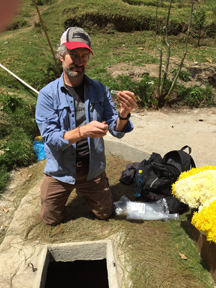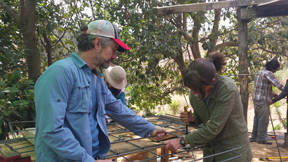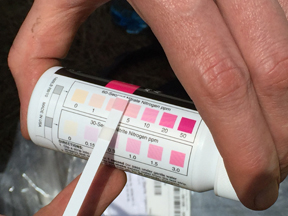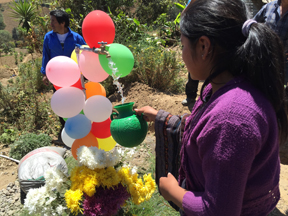By Dr. Pat Gorski, WSLH Environmental Health Division
As a member of the American Water Works Association (AWWA), I have long noticed that the Wisconsin chapter has a committee — Wisconsin Water for the World — that works to provide resources for safe drinking water and improved sanitation to people in developing communities throughout the world.

Dr. Pat Gorski sampling spring water in a buried cistern for coliform bacteria and E. coli testing.
This past March, my wife Madeline and I finally decided to go on one of their service trips to a rural village in Guatemala (Tzay), which is near the city of Solola. WSLH retiree Archie Degnan also went on the trip. Our team also consisted of Rotary members from Kenosha, WI, and Florida. Although the team was there for two weeks, Madeline and I only went for the final week.
The project would not have been possible without prior work done by the village, which was coordinated by Lynn Roberts, an American who lives in Guatemala full-time, and a local engineer. We also greatly benefited by having two local interpreters, Leo and Jose, who spoke English, Spanish and the local Mayan dialect (K’iche’, or called “Ketchikan”).
This specific project collected spring water at the base of a hill into a large storage tank and then pumped it up to the top of a hill into a second large storage tank, which then gravity-fed the water to roughly 50 households. Typically, the village does not have dependable drinking water availability (only 30 minutes per day on average); therefore drinking water has to be physically hauled daily from the spring up to each house.
The storage tanks had to be built on-site with concrete and rebar, as well as concrete platforms for the household wash basins, which serve as the sole source of water for each house. All the trenches for piping had to be dug by hand, as well as connecting and laying the PVC pipe.
The project provided clean dependable drinking water for the village, but also proper drainage for used waste water. I was able to do on-site confirmatory testing of the drinking water for nitrate, coliform and E.coli bacteria.
The work was very satisfying and we felt much appreciated by the villagers, especially the kids, although we couldn’t speak much Spanish. It was a great reality adjustment to see how a large portion of the world lives and experience first-hand that not everyone can easily turn on a tap to get instantaneous drinking water.
The implementation team was a great group of people to work with. We definitely had to be very flexible in our daily expectations, but we successfully had water flowing to the taps by the end of the trip, followed by the entire village turning out for a wonderful celebration.

Pat and his wife Madeline build a rebar cage for cement platforms to hold a wash basin. The wash basin will be the source of water for a house.

Dr. Pat Gorski holds a test strip that tests for both nitrate and nitrite. The test strips are a quick and easy way to test on-site without other analytical equipment. The strip shows 5 ppm nitrate, which is below the EPA limit of 10 ppm – so the water is fine in regard to nitrate.

During a celebration of the newly flowing water, a woman from the village catches water in a pitcher.
